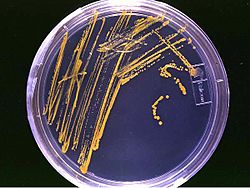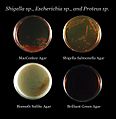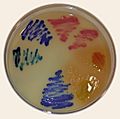Growth medium facts for kids
A growth medium or culture medium is a solid or liquid containing nutrients. It is designed to support the growth of microorganisms or cells, or small plants like moss. There are different types of media for growing different types of cells.
There are a wide range of growth media used in biology. Some of the basic types are:
- Undefined versus defined media: with defined media we know exactly what chemicals are in them.
- Selective media: for example, a medium with an antibiotic added. The only things which grow are those resistant to the antibiotic.
- Differential media: these distinguish one microorganism type from another growing on the same plate.
- Transport media: these have just enough to let organisms survive.
- Enriched media: contain extra amino acids and other building blocks. Used to harvest a wide range of organisms from a particular source.
Images for kids
-
US Food and Drug Administration scientist tests for Salmonella
-
A culture of salmonella bacteria
-
Physcomitrella patens plants growing axenically on agar plates (Petri dish, 9 cm diameter)
-
Blood-free, charcoal-based selective medium agar (CSM) for isolation of Campylobacter
-
Blood agar plates are often used to diagnose infection. On the right is a positive Staphylococcus culture; on the left is a positive Streptococcus culture.
See also
 In Spanish: Medio de cultivo para niños
In Spanish: Medio de cultivo para niños









